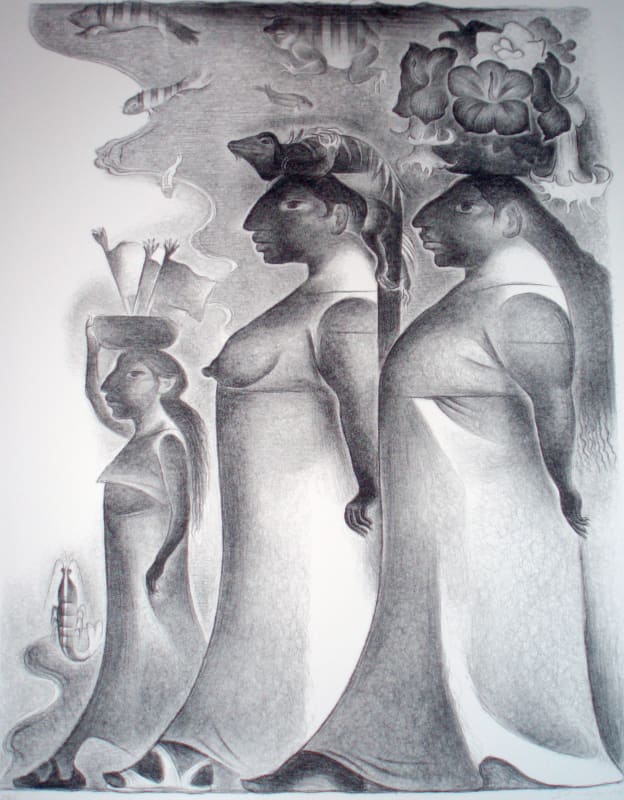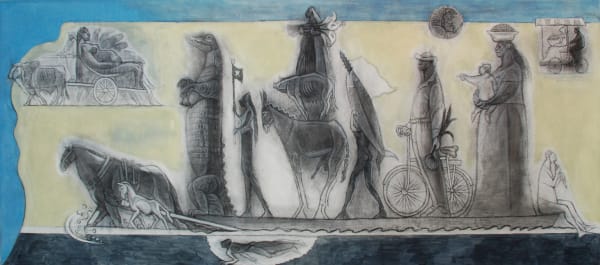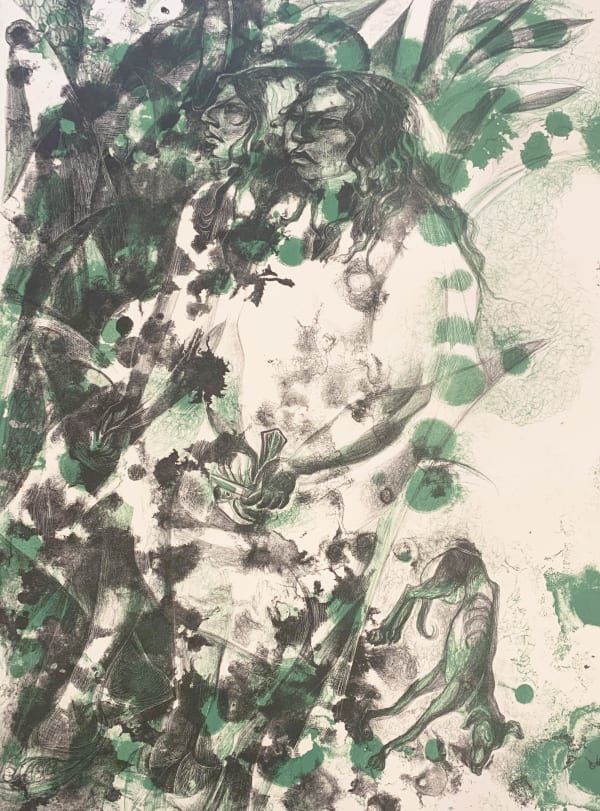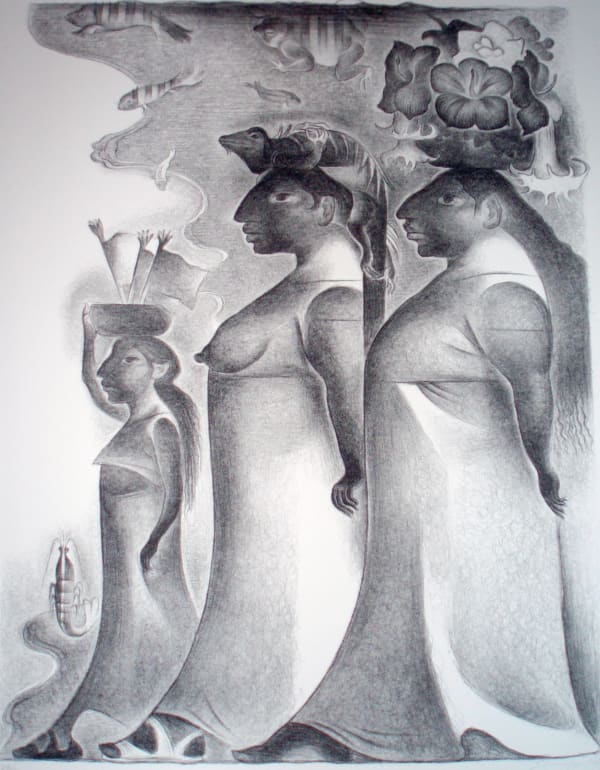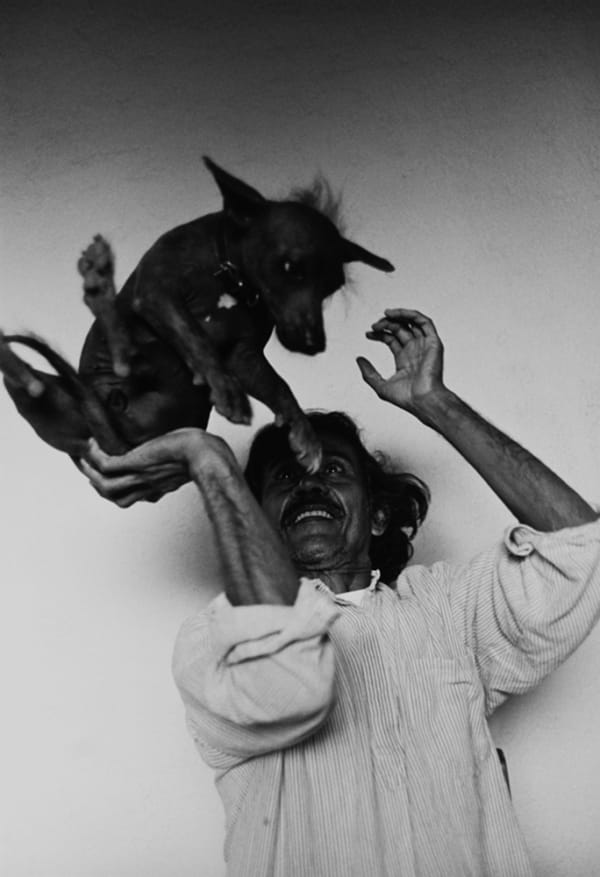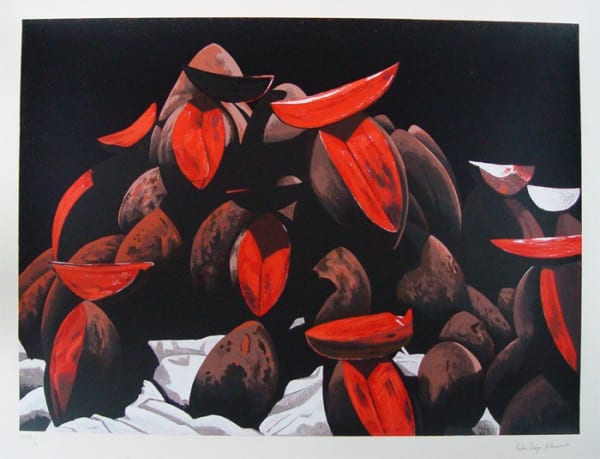Shinzaburo Takeda Japanese, b. 1935
Though born in Seto, Japan, Shinzaburo Takeda is often referred to as the “most Mexican” of the Oaxacan-born artists. Trained at the University of Fine Arts in Tokyo (1957), he visited Mexico in 1963 and never left. In Mexico City, he studied mural paintings with Armando Carmona and Luis Nishizawa at the Escuela Nacional de Artes Plásticas “San Carlos.” He studied lithography with Francisco Vasquez at the Escuela Nacional de Artes Gráficas. From 1965 to 1977, Takeda worked as a painter and graphic artist for the Mexican Museo Nacional de las Culturas. In 1978, he moved to Oaxaca and began a new career as an art professor at the Escuela de Bellas Artes de la Universidad Autónoma Benito Juárez de Oaxaca. Many of Oaxaca’s most celebrated new artists, such as Alejandro Santiago, studied with Shinzaburo Takeda. Since 1980, Takeda has been the head of the Department of “Artes Plásticas” at the Oaxaca City University. In his years in Oaxaca, Takeda has been able to pursue his longtime interest in documenting the traditional cultures of Mexico; their ceremonies and festivals have become an inspiration to much of his work.
He observes and captures the customs and everyday practices of the indigenous peoples and then translates these into his own visual vocabulary of traditional Mexican imagery. The Nahual is one aspect of the indigenous cultures and belief systems that Takeda repeatedly returns to and conjures up in his prints. With its origins in the ancient Zapotec and Mixtec mythologies of Southern Mexico, the Nahual acts as a spirit guardian to each individual and reveals itself in the animal-human figures that permeate Takeda’s work. The duality of the Nahual is expressed through the totem-like forms he builds, where they can take on anything from a playful to an almost menacing nature. Takeda’s fascination with Mexican culture is forever present in his work and is absorbed and shared by any and all who consider the unique interpretations and imagery in his paintings and prints.
Takeda structures the surface of his paintings with a grid, a traditional system for an artist to work, but does not hide the grid when painting over it. He integrates it into each of his paintings, revealing the process the artist uses from the early stages of his work.
-
 Shinzaburo TakedaRio Ostuta III, 2011Oil and charcoal on canvas23.75 x 53.5"
Shinzaburo TakedaRio Ostuta III, 2011Oil and charcoal on canvas23.75 x 53.5" -
 Shinzaburo TakedaMujeres de Mayo, 2010Metal plate lithograph with charcoal17 x 23 in
Shinzaburo TakedaMujeres de Mayo, 2010Metal plate lithograph with charcoal17 x 23 in
43.2 x 58.4 cm3 / 30 -
 Shinzaburo TakedaLacandonas, 20072-color lithograph31.5 x 23.75 in
Shinzaburo TakedaLacandonas, 20072-color lithograph31.5 x 23.75 in
80 x 60.3 cm3 / 40 -
 Shinzaburo TakedaChacahua, 2005Color pencil and watercolor on arches paper22.5 x 29.5 in
Shinzaburo TakedaChacahua, 2005Color pencil and watercolor on arches paper22.5 x 29.5 in
57.1 x 74.9 cm -
 Shinzaburo TakedaMangos, 2004Oil on canvas23.5 x 31.5 in
Shinzaburo TakedaMangos, 2004Oil on canvas23.5 x 31.5 in
59.7 x 80 cm -
 Shinzaburo TakedaDorado al Istmo, 1994black & white lithograph31.5 x 23.75"26 / 30
Shinzaburo TakedaDorado al Istmo, 1994black & white lithograph31.5 x 23.75"26 / 30
-

Neo-Surrealism & Magic Realism
February 16 - May 7, 2022 San AntonioRuiz-Healy Art is pleased to announce "Neo-Surrealism & Magic Realism". The exhibition includes dreamlike and figurative works that reference and react to the current political and ecological context; fantastical visions, mythology, and magical thinking influence the genres. Featured artists include: Juan Alcazar, RF Alvarez, Bruno Andrade, Victor Chaca, Juan de Dios Mora, Pedro Friedeberg, Luis Gal, Irma Guerrero, Roger Von Gunten, Rodolfo Morales, Katie Pell, Gugger Petter, Jose Luis Rivera-Barrera, Shinzaburo Takeda, Leticia Tarrago, Patssi Valdez, and Bettie Ward.Read more -

Made in Mexico
September 13 - November 3, 2018 San AntonioRuiz-Healy Art presents Made in Mexico, a group exhibition comprised of Mexican artists. The exhibition explores the ways artists have sought to explain their world in terms of an alternate reality, drawn from imagination, poetry, nature, and myth.Read more -

Latin American Printmakers
May 31 - June 29, 2012 San AntonioAn exhibit of prints featuring work by:Read more
Juan Alcazár, Javier Arévalo, Pedro Diego Alvarado-Rivera, Jose Luis Cuevas, Pedro Friedeberg, Alberto Gironella, Sergio Hernández, Joy Laville, Nicolás Leiva, Rodolfo Morales, Carmen Parra, Shinzaburo Takeda, Francisco Toledo, and Roger Von Gunten. -

Shinzaburo Takeda
November 7 - December 21, 2007 San AntonioRuiz-Healy Art is please to present an exhibition of paintings and works on paper by Japanese Mexican artist Shinzaburo Takeda . Between his loving depictions of Oaxaca and its people,...Read more

